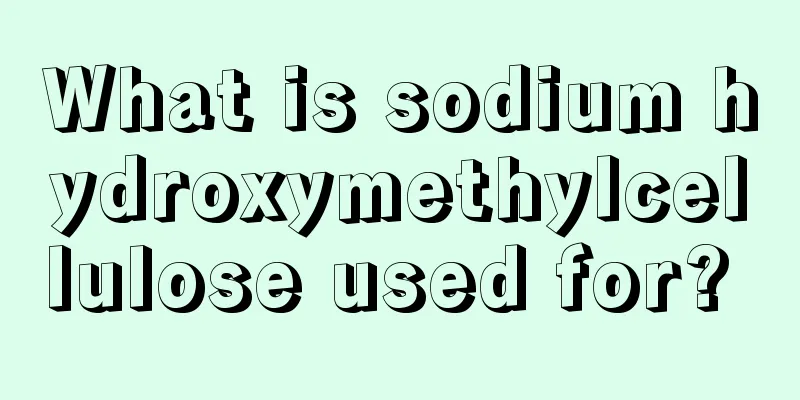What is sodium hydroxymethylcellulose used for?

|
Sodium hydroxymethyl cellulose is a white granular substance that is easily soluble in water and becomes sticky. Normally, the properties of sodium hydroxymethyl cellulose are very stable, but if it is dissolved in a liquid with a relatively high acidity, sodium hydroxymethyl cellulose will precipitate. Because of these characteristics, sodium hydroxymethyl cellulose has the following uses. What are the effects and uses of sodium carboxymethyl cellulose? Sodium carboxymethyl cellulose is the sodium salt of cellulose carboxymethyl ether, which is an anionic cellulose ether. It is a white or milky white fibrous powder or granules with a density of 0.5-0.7/cm2. It is almost odorless and tasteless and has hygroscopicity. It is easily dispersed in water to form a clear colloidal liquid, and is insoluble in organic solvents such as ethanol. Its effects and uses are summarized in detail below. Sodium carboxymethyl cellulose has the functions of bonding, thickening, strengthening, emulsifying, water retention and suspension. 1. Application of sodium carboxymethyl cellulose in the food industry: Sodium carboxymethyl cellulose is not only a good emulsifier stabilizer and thickener in food applications, but also has excellent freezing and melting stability, and can improve the flavor of the product and prolong the storage time. 2. Uses of sodium carboxymethyl cellulose in the pharmaceutical industry: In the pharmaceutical industry, it can be used as an emulsifier stabilizer for injections, a binder and film-forming agent for tablets. 3. CMC can be used as an anti-settling agent, emulsifier, dispersant, leveling agent, and adhesive for coatings. It can evenly distribute the solid content of the coating in the solvent, so that the coating will not be stratified for a long time. It is also widely used in paints. 4. Sodium carboxymethyl cellulose can be used as flocculant, chelating agent, emulsifier, thickener, water retaining agent, sizing agent, film-forming material, etc. It is also widely used in electronics, pesticides, leather, plastics, printing, ceramics, daily chemicals and other fields. Moreover, due to its excellent performance and wide range of uses, it is constantly exploring new application areas and has a very broad market prospect. nature: The aqueous solution is viscous. Viscosity and solubility are related to the degree of substitution. The solution is stable in the pH range of 2 to 10. Solids precipitate below pH 2, and the viscosity decreases rapidly above pH 10. Sodium carboxymethylcellulose (NaCMC or CMC for short) is a water-soluble cellulose ether that can make the viscosity of most commonly used aqueous solution preparations vary from a few cP to several thousand cP. The simplified molecular formula of NaCMC is as follows: Cell-O-CH2-COONaNaCMC is obtained by the reaction of monochloroacetic acid and alkaline cellulose. Alkali cellulose itself is produced by reacting cellulose with sodium hydroxide. The alkali cellulose step is necessary to facilitate the reaction between the etherifying agent and the cellulose chains. The degree of substitution (DS) and degree of polymerization (DP) are typical indicators of various grades of NaCMC. |
<<: What are the tips for using nitrocellulose?
>>: What is the function of cab cellulose?
Recommend
What are the early symptoms of lung cancer? Pay attention to these early symptoms of lung cancer
Pay attention to the early symptoms of lung cance...
How to choose a hospital for gastric cancer surgery
Gastric cancer is a common malignant tumor diseas...
Can the internal organs of sea cucumbers be eaten? Eight benefits of sea cucumbers
Sea cucumber is one of the eight treasures of the...
What are the symptoms of facial neuritis during the recovery period
Many people will experience facial nerve paralysi...
Is liver cancer contagious? Doctors explain common knowledge about liver cancer
When talking about liver diseases, many people th...
Is it okay to wear contact lenses?
Nowadays people use mobile phones and computers e...
How long can you live after being diagnosed with pancreatic cancer
How long can you live after being diagnosed with ...
Why do I feel so many small bumps on my back?
Many people have had similar experiences of getti...
What is the difference between AC and TC chemotherapy regimens for breast cancer
What is the difference between breast cancer chem...
What is the reason why hens lay soft-shell eggs
As we all know, hens laying soft-shell eggs is a ...
Can chronic atrophic gastritis be cured?
The problem of chronic atrophic gastritis serious...
Thyroid nodule 3 cm
Thyroid nodules are a relatively common symptom. ...
Is endometrial cancer related to genetics?
1. In recent years, studies have found that this ...
Can I get pregnant if I have tongue cancer?
Why do more and more elders now hope that young p...
Big belly like being pregnant?
Today's society is an era of competing for lo...









